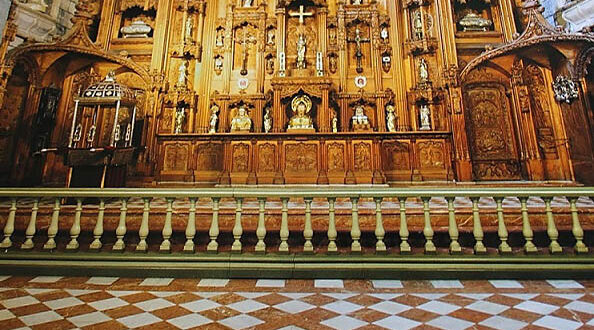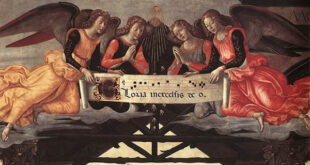Introduction: The Sacred Threshold We’ve Forgotten
In many churches, especially older ones, there’s a structure that often goes unnoticed—or has been removed altogether: a low railing made of wood or marble, sometimes covered with a white cloth, located in front of the altar. It’s known as the communion rail or altar rail, and for centuries, it was the place where the faithful knelt to receive Jesus in the Eucharist. Today, with the rise of Communion in the hand, standing reception, and a general loss of the sense of mystery, the communion rail seems like a relic from another era… but what if its return were, in fact, urgent?
This article is not simply an aesthetic or traditionalist defense. It’s an invitation to rediscover the deep theological and pastoral meaning of the communion rail as a symbol and instrument of worship, humility, and communion. Because behind that forgotten railing lies a world of meanings that can transform the way we live the Eucharist—and how we live as Christians.
I. What Is the Communion Rail?
The communion rail is a low barrier, usually made of wood, marble, or wrought iron, separating the sanctuary (or presbytery) from the rest of the church. In traditional liturgical use, it served as the place where the faithful knelt to receive Holy Communion during Mass. It was typically covered with a white cloth, a sign of purity and divine presence, and was attended by altar servers or ministers who accompanied the moment with a Communion paten and sometimes a lit candle.
More than just a functional structure, the communion rail is a powerful theological symbol: it represents the invisible line between the human and the divine, the threshold where Heaven and Earth meet. The altar beyond it is Calvary; and the communion rail, the Golgotha where we kneel to receive the Body of Christ with reverence and holy fear.
II. A Bit of History: From Screens to Sacred Space
Since the early centuries of Christianity, churches have been constructed with a hierarchical and theological sense of space. The area where the Sacrifice was offered was sacred, and not everyone could freely access it. This awareness led to the separation of the sanctuary by means of screens or railings, as is still seen in many Orthodox churches and some Gothic cathedrals.
During the Middle Ages, this separation evolved into a lower railing that allowed the faithful to approach—but in an orderly and reverent manner. With the development of the Roman Rite and the growing centrality of the Eucharist, the communion rail acquired prominence as the privileged place for receiving the Sacrament.
It wasn’t simply a “distribution line”; it was a liturgical act full of solemnity. The faithful would approach in silence, kneel, and wait for the priest—whose hands were consecrated—to place the Bread of Life on their tongue. The silence, the candlelight, and the whispered prayer “Corpus Domini nostri Iesu Christi custodiat animam tuam in vitam aeternam” created an atmosphere of profound adoration.
Following the post-conciliar liturgical reforms, communion rails were removed in many places, considered as barriers or symbols of clericalism. But much more than a physical structure was lost: a catechetical gesture, a pedagogy of mystery, and a sign of humility before the sacred were all swept away.
III. The Communion Rail as a Eucharistic Symbol
Every element in the liturgy has meaning. The communion rail is no exception. It brings together several spiritual dimensions:
- Humility: Kneeling expresses the truth of our smallness before the Almighty God who gives Himself to us. Like the centurion in the Gospel, we say with our bodies: “Lord, I am not worthy to have you enter under my roof” (Mt 8:8).
- Adoration: By kneeling before the Eucharist, we profess our belief in the Real Presence of Christ. This is not bread—it is the Son of God.
- Liturgical Communion: At the communion rail, there is no “line”; the faithful participate in a common act of receiving the Sacrament in silence and recollection, facing the altar and not the minister.
- Sacramentality of Space: The communion rail reminds us that a church is not an auditorium, but a sacred place. The altar is not an ordinary table, and what happens there is not merely symbolic, but a real sacrifice.
- Piety and Spiritual Education: Children learn to kneel, to wait patiently, to fix their gaze on the priest, to live in silence. The body educates the soul.
IV. What Does Sacred Scripture Say?
Although the concept of a “communion rail” does not appear literally in the Bible, its meaning is deeply rooted in the Word of God. We can recall the moment when Moses approaches the burning bush, and God says:
“Do not come any closer. Remove the sandals from your feet, for the place where you are standing is holy ground” (Exodus 3:5).
Saint Paul also reminds us of the seriousness of approaching the Body of Christ:
“Whoever eats the bread or drinks the cup of the Lord unworthily will be guilty of the body and blood of the Lord. […] For anyone who eats and drinks without discerning the body, eats and drinks judgment upon himself” (1 Corinthians 11:27,29).
These words invite us to recover reverence. The communion rail helps us precisely to “discern the Body” and not trivialize that sacred moment when God enters our soul.
V. Practical Guide: How to Recover and Live the Meaning of the Communion Rail
a) For the Faithful:
- Seek out churches where the communion rail is still in use. If there isn’t one, kneel anyway if your health allows it.
- Remember you are before the King of Kings. Even without a physical railing, your heart can kneel inwardly.
- Dress with dignity and prepare your soul with confession. The communion rail is a place of intimate encounter with Christ, not a social ritual.
- Avoid distractions. Upon arriving, close your eyes, bow your head, and say mentally: “Lord, increase my faith, my humility, and my love.”
- Teach your children the value of the communion rail. Let them kneel with you if possible. They are standing on holy ground!
b) For Priests and Ministers:
- Promote the use of the communion rail where possible. If it was removed, consider reinstating it or using it symbolically.
- Remember that you are a custodian of the Mystery. Help the faithful experience the Eucharist with awe and devotion.
- Lead by example: celebrate Mass reverently, distribute Communion with recollection, and train your servers in this same spirit.
- Preach about the importance of signs. This is not about “going back in time,” but about returning to what is essential.
VI. The Communion Rail Today: Barrier or Bridge?
Critics of the communion rail often say it “separates” the faithful from the altar, that it’s a “symbol of clericalism,” or “unnecessary in a participatory liturgy.” But nothing could be further from the truth. The communion rail is not a barrier, but a sacred bridge—a threshold where God and man meet, where the soul kneels to receive the One who descends from Heaven.
In times of liturgical confusion, of loss of the sacred, and of Eucharistic relativism, the communion rail can be a prophetic sign. Not out of nostalgia, but out of spiritual necessity. Because kneeling is not humiliation: it is recognition of the Holy. Because receiving on the tongue is not outdated: it is welcoming Christ with the clean hands of the soul. Because facing the altar rather than the minister means centering the liturgy on Christ.
Conclusion: Rebuilding the Communion Rails of the Soul
Perhaps there’s no communion rail in your parish. Perhaps you’re not allowed to kneel. Perhaps you have to endure misunderstanding. But you can still rebuild within your soul the true meaning of the communion rail. Make your heart that threshold where faith kneels, where love waits, where Christ can enter quietly—without haste, without irreverence.
The communion rail is not a luxury of the past. It is a necessity of the present. Because if we don’t learn to kneel before God, we will end up kneeling before the idols of the world.
And you—do you already have a communion rail in your soul?






